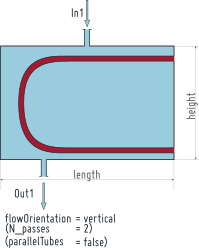IdealShell L2
Created Monday 08 April 2013
A simple heater/cooler model with ideally stirred phases at the shell side and a heat port for transferring a heat flow. The tube bundle side is not modelled.
1. Purpose of Model

The model is able to transfer a heat flow from/to a fluid via a heat port without modelling the tube side. The geometry definition considers the volume of a tube bundle inside the shell side, though. The model can be used, whether if a known heat flow is transferred to a fluid via a heat exchanger or if a heat flow is transferred from a defined temperature boundary.
2. Level of Detail, Physical Effects Considered and Physical Insight
2.1 Level of Detail
Referring to Brunnemann et al. [1], this model refers to the level of detail L2 because the system is ideally stirred at the shell side.
2.2 Physical Effects Considered
- dynamic conservation of energy (neglecting kinetic energy terms) in condensating and cooling flows
- dynamic conservation of mass (neglecting kinetic energy terms) in condensating and cooling flows
- strongly reduced momentum balance, taking static pressure differences due to friction losses and geostatic into account
- pressure losses due to friction at shell side
- calculation of heat transfer at shell side
2.3 Level of Insight
Heat Transfer
shell side
- Basics:ControlVolumes:Fundamentals:HeatTransport:Generic HT:Constant L2 : a constant heat transfer coefficient
- Basics:ControlVolumes:Fundamentals:HeatTransport:Generic HT:IdealHeatTransfer L2 : ideal heat transfer, i.e. kc is infinite (see also the remarks for usage)
- Basics:ControlVolumes:Fundamentals:HeatTransport:Generic HT:CharLine L2 : heat transfer coefficient calculated from nominal value and a mass flow dependent correction
Pressure Loss
shell side
- Basics:ControlVolumes:Fundamentals:PressureLoss:Generic PL:NoFriction L2 : friction free flow between inlet and outlet
- Basics:ControlVolumes:Fundamentals:PressureLoss:Generic PL:LinearPressureLoss L2 LinearPressureLoss L2 : Linear pressure loss based on nominal values, different zones are seen in parallel, pressure loss is located at flanges
- Basics:ControlVolumes:Fundamentals:PressureLoss:Generic PL:QuadraticNominalPoint L2 : Quadratic pressure loss based on nominal values, different zones are seen in parallel, pressure loss is located at flanges, density independent
- Basics:ControlVolumes:Fundamentals:PressureLoss:VLE PL:PressureLossCoefficient L2 : Density dependent pressure loss based on zeta value
- Basics:ControlVolumes:Fundamentals:PressureLoss:VLE PL:QuadraticNominalPoint L2 : Density dependent, quadratic pressure loss based on nominal values
Phase Separation
shell side
Basics:ControlVolumes:Fundamentals:SpatialDistributionAspects:IdeallyStirred : ideally mixed phases
3. Limits of Validity
- ideal stirred phases, i.e. if phase separation at shell side needs to be considered the model loses validity
- no modelling of tube side
4.1 Physical Connectors
Basics:Interfaces:FluidPortIn inlet
Basics:Interfaces:FluidPortOut outlet
Basics:Interfaces:HeatPort a heat
5. Nomenclature
6. Governing Equations
6.1 System Description and General model approach
This model extends from:
- Basics:ControlVolumes:FluidVolumes:VolumeVLE L2 volume of the shell side
7. Remarks for Usage
- For the sake of completeness two more heat transfer models shall be mentioned:
- Basics:ControlVolumes:Fundamentals:HeatTransport:VLE HT:NusseltShell1ph L2 :heat transfer coefficient based on geometry, media data and flow regime - Nusselt number
- Basics:ControlVolumes:Fundamentals:HeatTransport:VLE HT:NusseltShell2ph L2 :heat transfer coefficient based on geometry, media data and flow regime - Nusselt number
8. Validation
9. References
[1] Johannes Brunnemann and Friedrich Gottelt, Kai Wellner, Ala Renz, André Thüring, Volker Röder, Christoph Hasenbein, Christian Schulze, Gerhard Schmitz, Jörg Eiden: "Status of ClaRaCCS: Modelling and Simulation of Coal-Fired Power Plants with CO2 capture", 9th Modelica Conference, Munich, Germany, 2012
10. Authorship and Copyright Statement for original (initial) Contribution
Author:
DYNCAP/DYNSTART development team, Copyright 2011 - 2022.
Remarks:
This component was developed during DYNCAP/DYNSTART projects.
Acknowledgements:
ClaRa originated from the collaborative research projects DYNCAP and DYNSTART. Both research projects were supported by the German Federal Ministry for Economic Affairs and Energy (FKZ 03ET2009 and FKZ 03ET7060).
CLA:
The author(s) have agreed to ClaRa CLA, version 1.0. See https://claralib.com/pdf/CLA.pdf
By agreeing to ClaRa CLA, version 1.0 the author has granted the ClaRa development team a permanent right to use and modify his initial contribution as well as to publish it or its modified versions under the 3-clause BSD License.
11. Version History
- 2012 -v 0.1 - initial implementation - Friedrich Gottelt, XRG Simulation GmbH
- 2016 -v 1.1.0 - propagated the flowOrientation,
- changed default values for z_in and z_out - Timm Hoppe, XRG Simulation GmbH
- 08.01.2019 -v 1.4.0 - introduced parameter tubeOrientation, models are parametrisable in a more flexible way - Timm Hoppe and Annika Kuhlmann, XRG Simulation GmbH, Lasse Nielsen TLK Thermo GmbH
